Sabal
Sabal is a genus of palms (or fan-palms) endemic to the New World. Currently, there are 17 recognized species of Sabal, including one hybrid species.[4] The species are native to the subtropical and tropical regions of the Americas, from the Gulf Coast/South Atlantic states in the Southeastern United States, south through the Caribbean, Mexico, and Central America to Colombia and Venezuela. Members of this genus are typically identified by the leaves which originate from a bare, unarmed petiole in a fan-like structure. All members of this genus have a costa (or midrib) that extends into the leaf blade. This midrib can vary in length; and it is due to this variation that leaf blades of certain species of Sabal are strongly curved or strongly costapalmate (as in Sabal palmetto and Sabal etonia) or weakly curved (almost flattened), weakly costapalmate, (as in Sabal minor). Like many other palms, the fruit of Sabal are drupe, that typically change from green to black when mature.
| Palmetto | |
|---|---|
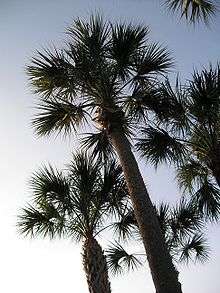 | |
| Sabal palmetto | |
| Scientific classification | |
| Kingdom: | Plantae |
| Clade: | Tracheophytes |
| Clade: | Angiosperms |
| Clade: | Monocots |
| Clade: | Commelinids |
| Order: | Arecales |
| Family: | Arecaceae |
| Subfamily: | Coryphoideae |
| Tribe: | Sabaleae |
| Genus: | Sabal Adans.[1] |
| Type species | |
| Sabal adansonii Guers.[2] | |
| Synonyms[3] | |
| |
Species
| Image | Name | Distribution |
|---|---|---|
| Sabal antillensis M.P.Griff. | Curaçao[4][5] | |
 | Sabal bermudana L.H.Bailey | Bermuda palmetto (Bermuda) |
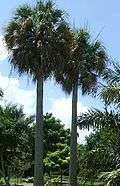 | Sabal causiarum (O.F. Cook) Becc. | Puerto Rico palmetto (Puerto Rico, United States Virgin Islands, British Virgin Islands, Haiti, Cuba, and the Dominican Republic) |
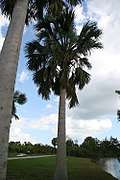 | Sabal domingensis Becc. | Hispaniola palmetto (Cuba, the Dominican Republic, and Haiti) |
 | Sabal etonia Swingle ex Nash | scrub palmetto (peninsular Florida, United States) |
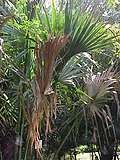 | Sabal gretheriae H.J.Quero.R. | Yucatán palmetto (Quintana Roo, Mexico) |
| Sabal lougheediana M.P.Griff. | Bonaire[5] | |
 | Sabal maritima (Kunth) Burret | Jamaica and Cuba |
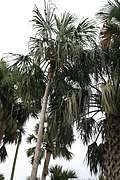 | Sabal mauritiiformis (H.Karst.) Griseb. & H.Wendl. | palma de vaca (southern Mexico to northern Colombia, Venezuela, and Trinidad) |
 | Sabal mexicana Mart. | Mexican palmetto (southern Texas south through Mexico to Nicaragua) |
 | Sabal miamiensis | Miami palmetto; southern Florida, sometimes treated as a distinct species or included in Sabal etonia |
 | Sabal minor (Jacq.) Pers. | dwarf palmetto (northeastern Mexico, Southeastern United States: Florida north to North Carolina, west to Texas) |
.jpg) | Sabal palmetto (Walter) Lodd. ex Schult. & Schult.f. | cabbage palmetto (Cuba, the Bahamas, Turks and Caicos Islands, Southeastern United States: Florida north to North Carolina, west to Texas) |
_001.jpg) | Sabal pumos (Kunth) Burret | royal palmetto (Guerrero, Michoacán, and Puebla, Mexico) |
 | Sabal rosei (O.F.Cook) Becc. | coast of northwestern Mexico |
| Sabal uresana Trel. | Sonoran palmetto (Chihuahua and Sonora, Mexico) | |
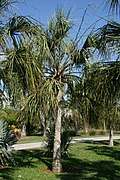 | Sabal yapa C.Wright ex Becc. | cana rata (Yucatán Peninsula, Belize, Cuba, and Guatemala)[6][7] |
Prehistoric taxa
Extinct species within this genus include:[9]
Formerly placed here
- Serenoa repens (W.Bartram) Small (as S. serrulata (Michx.) Nutt. ex Schult. & Schult.f.)[7]
Fossil record
These plants lived from the Cretaceous to Quaternary (from 66 million to 12 thousand years ago). Fossils have been found in United States, Italy, Switzerland, Germany, Japan, the United Kingdom, and France.[9] Leaf fossils of Sabal lamanonis have been recovered from rhyodacite tuff of Lower Miocene age in Southern Slovakia near the town of Lučenec.[11]
Phylogenetic work in Sabal (1990s – present)
The name Sabal was first applied to members of the group by Michel Adanson in the 18th century.[12] Previous names that this genus was associated with include Corypha, Chamaerops, Rhapis.[13][12] This section highlights important phylogenetic work done within the genus Sabal.
In 1990, Scott Zona outlined key morphological and anatomical characters that he used to analyze species relationships of Sabal. Through this analysis of characters, Zona produced a cladogram that portrays evolutionary relationships amongst 15 species of Sabal.[13] Based on the distribution of species within his cladogram, Zona recognized four distinct clades.[13] The clades within his study include (Clade 1) Sabal minor; (Clade 2) Sabal bermudana, Sabal palmetto, Sabal miamiensis, and Sabal etonia; (Clade 3) Sabal maritima, Sabal domingensis, Sabal causiarum, Sabal maurittiformis, Sabal yapa, Sabal mexicana, and Sabal guatemalensis; (Clade 4) Sabal uresana, Sabal rosei, and Sabal pumos.[13] These clades associate closely with geographic distributions.[13] All of the species within Clade 3 occur in the Greater Antilles and southern Mexico, where species that occur in the Greater Antilles are more closely related to each other than those that occur in southern Mexico.[13] Although Clade 4 also occurs in Mexico, these species occur on the west coast where they are geographically separated from the Mexican species within the southern part of the country.[13] The remaining two clades, Clade 1 and Clade 2 predominantly occur in the southeastern United States although S. palmetto and S. minor are also known from Cuba and the Bahamas (S. palmetto) and northern Mexico (S. minor).[13] Sabal bermudana is only known from the Bermuda Islands.[13]
In 2016 Heyduk, Trapnell, Barrett, and Leebens-Mack conducted a new study on Sabal that analyzed molecular (e.g. nuclear, plastid) data from 15 species of the group.[14] This study incorporated plastid and nuclear sequence data that together were used to estimate the relatedness between the species of Sabal.[14] The results of the study show species relationships to be different from the distribution of Zona's cladogram.[13][14] Within the framework of this study, a major difference between the results of Zona and this study is the placement of "Clade 4" (Sabal uresana, Sabal rosei, and Sabal pumos) which split and integrate these species throughout the phylogeny of Sabal.[13][14] The largest of the clades identified by Zona, "Clade 3" is disrupted significantly as it is split into multiple clades.[13][14] Although Sabal causiarum and S. domingensis retain their relationship as sister species, they are included in a clade that also includes S. maritima and S. rosei.[13][14] Despite the these disruptions in placement between these two studies, the overall integrity of "Clade 1" and "Clade 2" is in congruence with the clades established from the molecular data.[14][13]
Pollinators and parasitoids
Sabal species are used as food sources by several species of birds including Mimus polyglottos, Turdus migratorius, Dendroica coronata, Corvus ossifragus, and Drycopus pileatus, Caryobruchus,[15] and various species of hymenoptera. Bears (Ursus americanus) and racoons are also known to feed on fruit of various species of Sabal. Sabal palmetto is recorded to have its own lichen, Arthonia rubrocincta,[16] that only occurs on the leaf bases of the Cabbage Palm (Sabal palmetto). In Europe, the introduced Lepidopteran species Paysandisia archon has become a prominent pest whose larvae are known to feed on some of the cultivated species of Sabal.
Uses
Arborescent species are often transplanted from natural stands into urban landscapes and are rarely grown in nurseries due to slow growth. Several species are cultivated as ornamental plants and because several species are relatively cold-hardy, can be grown farther north than most other palms. The central bud of Sabal palmetto is edible and, when cooked, is known as 'swamp cabbage'. Mature fronds are used as thatch and for weaving mats.
Symbolic use
A silhouette of a palmetto (S. palmetto) appears on the official flag of South Carolina.[17]
Two images of S. palmetto appear on the Florida state seal.
Sabal palmetto is the state tree of both Florida and South Carolina.
S. palmetto has been used as a sign of freedom and independence in the Southern United States since the beginning of the Revolutionary War and especially during secession in the American Civil War.
References
| Wikimedia Commons has media related to Sabal. |
| Wikispecies has information related to Sabal |
- Michel Adanson (1763). Familles des plantes. 2 (in French). chez Vincent. pp. 495, 599.
- "Sabal Adans". TROPICOS. Missouri Botanical Garden. Retrieved 2009-10-16.
- "Sabal Adans". Germplasm Resources Information Network. United States Department of Agriculture. 2004-10-15. Archived from the original on 2009-08-26. Retrieved 2010-04-12.
- Griffith, M. Patrick; De Freitas, John; Barros, Michelle; Noblick, Larry R. (2017). "Sabal antillensis (Arecaceae): a new palmetto species from the Leeward Antilles". Phytotaxa. 303: 56–64. doi:10.11646/phytotaxa.303.1.4.
- Griffith, M. Patrick; Coolen, Quirijn; Barros, Michelle; Noblick, Larry R. (2019). "Sabal lougheediana (Arecaceae), a critically endangered, endemic pa;m species from Bonaire". Phytotaxa. 420: 095–102. doi:10.11646/phytotaxa.420.2.1.
- "Subordinate taxa of Sabal Adans". TROPICOS. Missouri Botanical Garden. Retrieved 2009-10-16.
- "GRIN Species Records of Sabal". Germplasm Resources Information Network. United States Department of Agriculture. Archived from the original on 2015-09-24. Retrieved 2010-07-07.
- GOLDMAN, DOUGLAS H.; KLOOSTER, MATTHEW R.; GRIFFITH, M. PATRICK; FAY, MICHAEL F.; CHASE, MARK W. (2011-08-19). "A preliminary evaluation of the ancestry of a putative Sabal hybrid (Arecaceae: Coryphoideae), and the description of a new nothospecies, Sabal × brazoriensis". Phytotaxa. 27 (1): 8. doi:10.11646/phytotaxa.27.1.2. ISSN 1179-3163.
- Paleobiology Database
- Manchester, Steven R. (1994). "Fruits and seeds of the Middle Eocene Nut Beds Flora, Clarno Formation, Oregon". Palaeontographica Americana. 58: 1–205.
- Vojtko, Rastislav (2016-10-21). "Miocénna flóra z lokalít Kalonda a Mučín" [Miocene flora from the localities Kalonda and Mučín]. Acta Geologica Slovaca (in Slovak). 1 (1): 65–70. ISSN 1338-0044. Retrieved 2019-07-08.
- Ramp, Paul F.; Thien, Leonard B. (1995). "A Taxonomic History and Reexamination of Sabal minor in the Mississippi Valley". Principes. 39 (2): 77–83.
- Zona, Scott (1990). "A Monograph of Sabal (Arecaceae: Coryphoideae)". Aliso. 12 (4): 583–666. doi:10.5642/aliso.19901204.02.
- Heyduk, Karolina; Trapnell, Dorset W.; Barrett, Craig F.; Leebens-Mack, Jim (2015-05-13). "Phylogenomic analyses of species relationships in the genus Sabal (Arecaceae) using targeted sequence capture". Biological Journal of the Linnean Society. 117 (1): 106–120. doi:10.1111/bij.12551. ISSN 0024-4066.
- i Monteys, Víctor Sarto; Aguilar, Lluís; Saiz‐Ardanaz, Marienza; Ventura, Daniel; Martí, Mercè (June 2005). "Comparative morphology of the egg of the castniid palm borer, Paysandisia archon (Burmeister, 1880) (Lepidoptera: Castniidae)". Systematics and Biodiversity. 3 (2): 179–201. doi:10.1017/S1477200005001635. ISSN 1477-2000.
- Grube, Martin; Lucking, Robert; Umana-Tenorio, Loengrin (September 2004). "A New Isidiate Species of Arthonia (Ascomycota: Arthoniaceae) from Costa Rica". Mycologia. 96 (5): 1159. doi:10.2307/3762099. ISSN 0027-5514. JSTOR 3762099.
- Netstate, South Carolina State Flag
External links
- Sabal images at Fairchild Tropical Botanical Gardens
- Sabal at Scanpalm